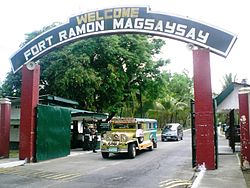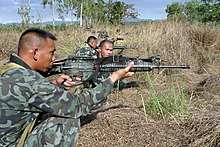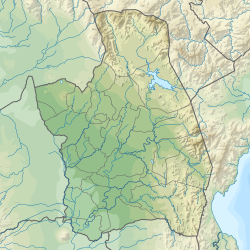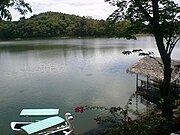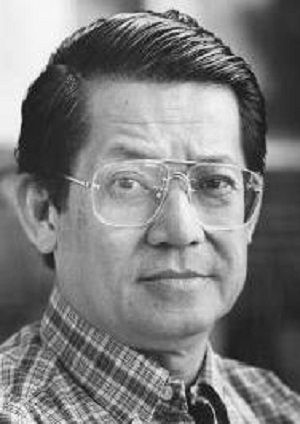
Benigno "Ninoy" SimeonAquino Jr., was a Filipino politician who served as a senator of the Philippines (1967–1972) and governor of the province of Tarlac. Aquino was the husband of Corazon Aquino, who became the 11th president of the Philippines after his assassination, and father of Benigno Aquino III, who became the 15th president of the Philippines. Aquino, together with Gerardo Roxas and Jovito Salonga, helped form the leadership of the opposition towards then President Ferdinand Marcos. He was the significant leader who together with the intellectual leader Sen. Jose W. Diokno led the overall opposition.

The People Power Revolution, also known as the EDSA Revolution or the February Revolution, was a series of popular demonstrations in the Philippines, mostly in Metro Manila, from February 22 to 25, 1986. There was a sustained campaign of civil resistance against regime violence and electoral fraud. The nonviolent revolution led to the departure of Ferdinand Marcos, the end of his 20-year dictatorship and the restoration of democracy in the Philippines.
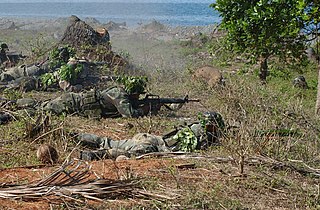
Operation Enduring Freedom – Philippines (OEF-P) or Operation Freedom Eagle was part of Operation Enduring Freedom and the global War on Terror. The Operation targeted the various Jihadist terror groups operating in the country. By 2009, about 600 U.S. military personnel were advising and assisting the Armed Forces of the Philippines (AFP) in the Southern Philippines. In addition, by 2014, the CIA had sent its elite paramilitary officers from their Special Activities Division to hunt down and kill or capture key terrorist leaders. This group had the most success in combating and capturing Al-Qaeda leaders and the leaders of associated groups like Abu Sayyaf.

Fort Irwin National Training Center is a major training area for the United States military in the Mojave Desert in northern San Bernardino County, California. Fort Irwin is at an average elevation of 2,454 feet (748 m). It is located 37 miles (60 km) northeast of Barstow, in the Calico Mountains.

Palayan, officially the City of Palayan, is a 5th class component city and capital of the province of Nueva Ecija, Philippines. According to the 2020 census, it has a population of 45,383 people, making it the least populated city in the Philippines.
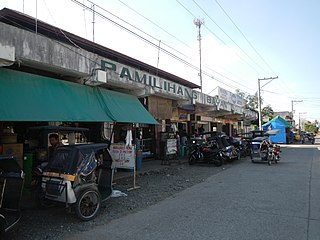
Laur, officially the Municipality of Laur, is a 3rd class municipality in the province of Nueva Ecija in Central Luzon region of Philippines. According to the 2020 census, it has a population of 38,263 people. Laur is located at the foothills of the Sierra Madre Mountains.

The Ninoy Aquino Stadium is an indoor sporting arena located in the Rizal Memorial Sports Complex in Manila, Philippines. Originally built in the 1950s, it was renovated and renamed for Philippine senator Benigno S. Aquino Jr. in 1989.
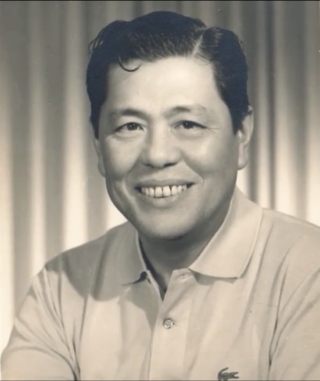
Jose Wright Diokno, also known as "Ka Pepe", was a Filipino nationalist, lawyer, and statesman. Regarded as the "Father of Human Rights," he served as Senator of the Philippines, Secretary of Justice, founding chair of the Commission on Human Rights, and founder of the Free Legal Assistance Group (FLAG), the premier group of Filipino human rights lawyers. Diokno is the only person to top both the Philippine Bar Examination and the board exam for Certified Public Accountants (CPA). His career was dedicated to the promotion of human rights, the defense of Philippine sovereignty, and the enactment of pro-Filipino economic legislation.
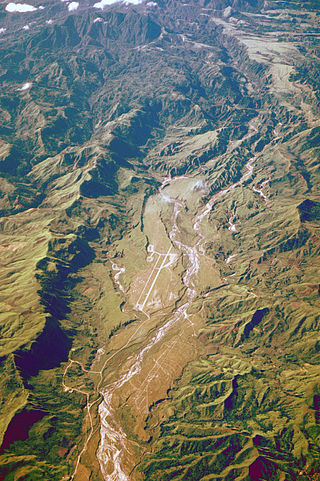
Colonel Ernesto Ravina Air Base (CERAB) or Crow Valley Gunnery Range, and formerly the Tarlac Military Testing Ground, was the main bombing range of the United States Armed Forces in the western Pacific, and by the Armed Forces of the Philippines. It is located in Camp O'Donnell in Tarlac, Philippines. The 42-mile facility is located approximately 22 kilometers from Clark Air Base and is primarily used for aerial combat training, which include bombing and strafing practice, as well as ground unit maneuver and live fire exercises.
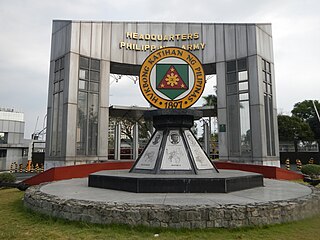
Fort Andres Bonifacio is the site of the national headquarters of the Philippine Army located in Taguig, Philippines. The camp is named after Andres Bonifacio, the revolutionary leader of the Katipunan during the Philippine Revolution.

Hermogenes Cendaña Esperon Jr. is a retired Philippine Army general who served as the National Security Adviser in the Cabinet of President Rodrigo Duterte from 2016 to 2022. He was the Chief of Staff of the Armed Forces of the Philippines from 2006 to 2008 and Commanding General of the Philippine Army from 2005 to 2006 under President Gloria Macapagal Arroyo. After his retirement from the military, he served in Arroyo's administration as the Presidential Adviser on the Peace Process and later as the head of the Presidential Management Staff.
José "Pepe" Chichioco Cojuangco Sr., KSS was a Filipino politician who served as Representative of the 1st District of Tarlac in the Philippines from 1934 to 1946. Cojuangco is one of the patriarchs of the Cojuangco clan. He was the father and grandfather of future Philippine presidents Corazon Aquino and Benigno Aquino III, respectively. His other grandchildren include actresses Kris Aquino and Mikee Cojuangco.

Rafael Manio Ileto was a Filipino general who served as the 22nd Secretary of the Department of National Defense (DND) of the Philippines. He also became the Vice Chief of Staff of the Armed Forces of the Philippines (AFP). He also served as Philippine Ambassador to Turkey, Iran, Cambodia, Thailand, and Laos.

Voltaire Tuvera Gazmin is a retired Filipino soldier who was the 35th Secretary of the Department of National Defense of the Philippines. Gazmin assumed office on 1 July 2010, after President Benigno S. Aquino III had issued the former's appointment the day before.
The Enhanced Defense Cooperation Agreement (EDCA) is an agreement between the United States and the Philippines intended to bolster the American–Philippine alliance. The agreement allows the United States to rotate troops into the Philippines for extended stays and allows the United States to build and operate facilities on Philippine bases for both American and Philippine forces. The U.S. is not allowed to establish any permanent military bases. The Philippines have personnel access to American ships and planes. This agreement has been the subject of criticism by some leftist groups in the Philippines.
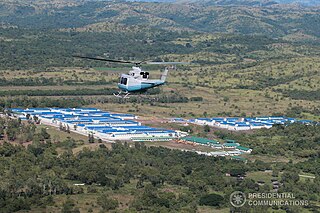
The Mega Drug Abuse Treatment and Rehabilitation Center (Mega DATRC), also known as the Mega Drug Treatment and Rehabilitation Center, is a drug rehabilitation center at Fort Magsaysay in Nueva Ecija, Philippines.

At 7:15 p.m. on September 23, 1972, President Ferdinand Marcos announced on television that he had placed the Philippines under martial law, stating he had done so in response to the "communist threat" posed by the newly founded Communist Party of the Philippines (CPP), and the sectarian "rebellion" of the Muslim Independence Movement (MIM). Opposition figures of the time accused Marcos of exaggerating these threats and using them as an excuse to consolidate power and extend his tenure beyond the two presidential terms allowed by the 1935 constitution. Marcos' signed Proclamation No. 1081 on September 21, 1972, marking the beginning of a fourteen-year period of one-man rule which effectively lasted until Marcos was exiled from the country on February 25, 1986. Proclamation No. 1081 was formally lifted on January 17, 1981, although Marcos retained essentially all of his powers as dictator until he was ousted in February 1986.

Eduardo "Ed" Drueco del Rosario is a Philippine Army veteran and government official who served as the first Secretary of Human Settlements and Urban Development of the Philippines under the Duterte administration, from January 2, 2020 to June 30, 2022. He previously served as Chairperson of the now-defunct Housing and Urban Development Coordinating Council which was abolished and replaced by the Department of Human Settlements and Urban Development created through Republic Act No. 11201 on February 14, 2019. Del Rosario served 37 years in the Armed Forces of the Philippines, retiring as a major general in 2012. His service included tours as commander of the AFP Southern Luzon Command and of the 2nd Infantry Division.

Mega Ligtas COVID Centers, also known as Temporary Treatment and Monitoring Facilities (TTMFs), are temporary non-hospital health facilities or emergency patient care centers established and managed by the Philippine government to accommodate COVID-19 patients at a provincial or regional level as part of its efforts to deal with the COVID-19 pandemic in the Philippines. Some facilities are also serving as quarantine sites for Filipino repatriates from other countries.
Historians estimate that there were about 70,000 individuals incarcerated by the authoritarian regime of Ferdinand Marcos in the period between his 1972 declaration of Martial Law until he was removed from office by the 1986 People Power Revolution. This included students, opposition politicians, journalists, academics, and religious workers, aside from known activists. Those who were captured were referred to as "political detainees," rather than "political prisoners," with the technical definitions of the former being vague enough that the Marcos administration could continue to hold them in detention without having to be charged.
